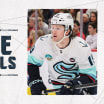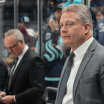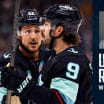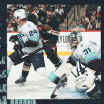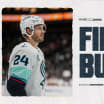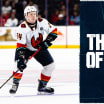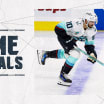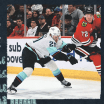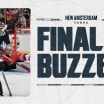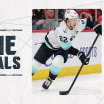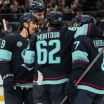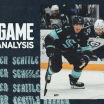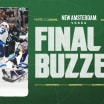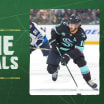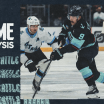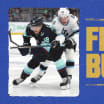You've been coaching for a while now. What got you at least initially interested in wanting to go into coaching?
I played 13 years. I got to a point where I knew the NHL wasn't going to happen, and I wanted to stay in the game. It's what I knew. I got together with Bruce Boudreau as a player assistant coach at the time (Mississippi Sea Wolves, ECHL). We'd won a championship, and eventually, he left, and I ended up taking over. And it's just been something I enjoy doing. I've always been a leader or a captain a lot of my career and I knew that I wanted to be in that type of role, and hockey is a great sport to be a part of. And when you can't play anymore, the next best thing is coaching, and hopefully, I can stay in it as long as possible because it's what I love, and it's a great sport to be a part of.
You mentioned Bruce Boudreau there...as a coach, you're always trying to learn. Whether it be from people you work with on the staff on a day-to-day basis or even in the off-season with people you may have worked with in the past or knew before, is there anybody that you really like to try to pick their brain or that has really been a mentor to you through this journey of yours?
Well, Bruce was my first guy, and I worked with Dean Evanson as an assistant together in Washington (NHL). We always had a great relationship and thought the game the same way. He's a guy I have a lot of respect for. Any guys you coach with...Dan (Bylsma) - coaching with him. You take little pieces of that, and then you think about the coaches you played for as a player like Tommy McVie, who just recently passed, was my first pro coach. I remember so many things from him, and just the way he did things, the things he said. You just take little pieces from everybody, and you mold it into what you like and use. And it's guided me this far. I've been fortunate to have some success and to be in the best league in the world for as long as I have. I'm blessed to be here and very appreciative.
What have you found that's most rewarding about being a coach in this game and in this league?
Well, you know, winning is great. I think we all love winning and winning championships and stuff. But the big thing for me is watching young players and help them reach their goals and have success. There's nothing better than running into guys…even last night, running into guys that I've worked with since they started in the league, and just to hear them say hello and appreciate what you did for them; that's important. I think we work hard as coaches, and we want to see our players have success and do well. And if we can have a little influence in that, I think that's as rewarding as it gets.
You're new to the coaching staff here in Seattle this season, but you know Coach Bylsma well. What's it been like reuniting with him and working with him again?
Well, you know, our time in Buffalo was a lot of fun. I enjoyed working with him, and he really gave me a lot of extra tasks and responsibilities, which I thought helped me grow as a coach. I appreciated everything that he did for me there, and I was excited to get back with him here in Seattle.
How have you seen him evolve as a coach from your last time officially working together?
I think everybody, as coaches, we grow every year. You learn different things. You get to see how other people do things, and you take some of that. I can see some changes. And just the way he approaches the game, the way he runs his bench, everything…you could just tell that he's evolved and is ready for this new challenge.
When you come into a new coaching staff, what is that process like? How do you guys come together to find a process and collaborate together? What's it been like with the whole new team?
Well, we had our meetings before the season started. We had a little retreat where we got together as coaches and just went over all the systems and how we wanted to run things, and just talked about personnel and just got to know each other as coaches. When you're coming into a new group, you want to find out how everybody ticks and how they work together. And I'm very fortunate to be with the group in here. I've had a lot of fun with them, and they're really easy to work with.
Let's get into defense. There's a trend now in hockey where you can allow people to shoot all day long; just keep them to the outside. Limiting quality versus quantity. Your teams have always been very good at that. Tell me how that approach has evolved for you?
The biggest thing where you've seen the evolution here is the skill of the players. These young guys coming into the league are very talented. You look at the power plays. (Some teams) can put two or three units together because the skill level is very high. So, I think defensively, you want to try to take away as much time and space as you can. Try to make it tough on the skilled players. And, we talk a lot about boxing out and allowing our goaltenders to see the puck. I think we really love when guys block shots, but ideally, we'd rather our goalies make the saves, and if we can keep that path clear to the net, I think that's very beneficial to everybody.
We talked with Steve Briere about goaltending, and it was cool to learn that in the game, sometimes he works with you and the players to make sure the goaltender and the defense are in sync based on what you're seeing. Tell me about how that process works from your side managing the blue line.
‘D’ and goalies work very closely with each other. There's got to be great communication, whether it's puck touches or just if they're screened, being able to communicate and direct traffic. I think everybody on the ice needs to know what's going on, and I especially think D and goalies have to work very closely. So, we want it as clean as possible; the sooner we can get that puck out of the zone, the we've done our job, and we can get going down the other end, where the fun stuff is.
How quickly can you make that kind of adjustment in the game when you or Steve see something and maybe something needs to change defensively?
I usually wait. I'm the last one off the bench (in games). I like to be there to talk to our starting goalie and find out if there's anything that he sees or we can change or do any differently. And sometimes he's got questions like ‘what do you see?’ and ‘what options are available to me?’ And then Steve and I will coordinate between periods. We can look at the video quickly to see if we can make any adjustments, and usually, that's the case. And I'm happy to have Steve's help. He’s up in the press box. He's got a good view - the game's easy to see up there. And sometimes on the bench, you miss a lot. You're trying to look for matchups; you're watching the other team's bench. So maybe you don't see everything that's going on in the ice, and there's a lot of action on the bench. So, the communication between Steve and myself is very important.
The role of a defender is changing in the NHL. You look at the (Vince) Dunn’s, you look at the (Zach) Werenski’s, the (Quinn) Hughes, the (Cale) Makars. Talk about what you're seeing in terms of how a stay-at-home defenseman used to be the standard in this league, and how the role is changing.
Every team I've been a part of has really started to get D more involved. I think they have to be a part of the offense. Coming out of our zone, we want at least one, if not both, D joining in the rush. We don't want to leave anybody behind us. We want to be in the play, and the teams that do that really well are very hard to defend against. So, we talk about that too. How we defend against that is trying to squeeze plays at the blue line, not allow those third, fourth, fifth, guys into the zone. You can be effective if you can kill plays at the blue line.
How has your coaching had to evolve as the position has evolved?
It changes. And you're always learning; you're always talking to players. When you're having a one on one video session with a guy, I want to hear what he's thinking, what he sees, because the game happens fast. Us as coaches have the play and pause button, we can slow things down. The game looks pretty simple at times. And I think that as a player, it's interesting to me if I see a situation, I want to know what he thought or what he sees in that, and then I could show him, maybe, what options were available to him. So, there's a learning process there. I just think the communication can really help. And I think it's so important as a coach now to have that communication. I want to go around after every game. I want to talk to every defenseman, and I want to see what they thought of their game. I'll let them know what I thought of their game or what things we want to change or get better at. And I just think having that open communication is beneficial for everybody.
Let's go to this team specifically but also in general. Coach Bylsma has talked about how different lines have different purposes or identities. And sometimes that applies to pairs as well. How do you think about putting two players together and making a pair and does each one have a different role or different fit?
Well, sometimes you have an offensive guy with a defensive guy. We've changed our parents a little bit here recently. And it's more just match ups like (Ryker) Evans and (Brandon) Montour. I could use them against a speed line - a team or line that's got a lot of speed because they're both great skaters. ‘Dunner’ and ‘Lars’ can play against anybody, they're that nice option to have - they have offense and defense combined. And then you Have ‘Rig’ (Jamie Oleksiak) and ‘Muzz’ (Josh Mahura). They're just good against a heavier line. If the opponent has a big third line, you need some heavier bodies to play against those guys. And all of that just gives you options. Again, you can change it all the time. I think you'll see, if we're down in a game, you're going to see our offensive guys out there a little bit more. Or when we're protecting the lead, you're going to see our defensive guys out there a little bit more. So, it changes from game to game and situations in the game.
How important is chemistry between pair partners? We talk about it with the forwards all the time, but we maybe don't talk about it with defensemen as much.
You have to have chemistry. Certain guys work really well together. You look at Dunn and (Adam) Larsson, they've been together since the beginning, and they work well. When you find that chemistry, it's good. And then you're also looking for a little bit of chemistry in games like if one ‘D’ pairing is playing well with a forward line, you try to get them out together as much as you can in situations like that. Or you're in a defensive situation…maybe you're protecting certain situations. So, we have pretty good flexibility with the group we have here, and that makes my job a little bit easier.
You mentioned Dunn and Larsson. They have been together forever and have that mix of skill sets that you talked about. They're also tremendously close friends. From your perspective, what is it that makes them work together so well?
Well, they talk a lot. You watch them, they eat dinner together - they're talking. They sit and have lunch -they're talking. They're on the bench - they're talking. And I think communication is great on the ice, but it also needs to be done off the ice. And I know that they talk about a lot of different situations. And usually, when I do video, I'll try to grab both of them together, and again, it's just listening to hear what they see and what adjustments we can make or any concerns that they have that hopefully we can fix.
Let's talk about Ryker Evans a little bit. I think it's easy to forget this is his first full NHL year because he's really folded in nicely. What have you seen from the player, and what are your expectations given what he's doing already?
Well, I think he's having a pretty good start here and again, he can do it all. He's a great skater. He's got a good shot. He sees the ice well. He's very mature for his age, and he's got that little bite to him. He'll go into a corner, and he doesn't care who it is, that's just the mindset he has. He's a competitive guy. He's had some great experience down in the minors with Dan and Jess (Campbell) where they had success and it's carried up here. You can just see that he's ready for this challenge. He's going to make young guy mistakes, and he's going to have games where he doesn't look as good as others, but that's just maturing. And again, I'm excited about his future. I think he's going to bring a lot to this organization.
Another newer face to the blue line that fans maybe didn’t know a lot about before is Josh Mahura. He’s another guy that has some snarl, but also skill. What have you seen from him? What makes him so valuable?
He's been a part of a Stanley Cup champion, so that's always valuable. He's just a great kid. He wants to work on his game all the time. He wants to do whatever he has to do to get a role on the ice, and he knows what it is, and he does it well. And you know, you see him throwing big hits to turn our game around, or he's making some big blocks. Those are things that really stand out to us. He came in, it was all new, and maybe he had a rough start, but he's worked his way in, and he's a guy that I'm very comfortable putting out there in the last minute or against certain guys, and he's earned that that spot. And you always want to see guys that are good people and work hard and care, and he is all of those things. That brings a lot of passion to our team.
On the offensive side of the game, it's easy for fans to see impact. You see a shot. You see a goal. Defense is harder to measure outside of a hit or a block shot. For a newer fan, if they want to appreciate defensive play, what should they be looking for?
If you look a lot of it starts with the D coming out of our D zone, making those good, simple passes. It doesn't have to be fancy or cute; it just has to be on the tape. And when we're doing that and we're connected and coming up the ice, we're usually not in the zone. I think defense sometimes it's good not to be noticed, but, we are blessed with some pretty offensive guys, and you'll see them shine - the Montour’s. You watch those guys in the offensive zone like ‘Dunner.’ They make things happen. And I think we can start all that by just shooting the puck, having that mindset. And when the puck comes to us, our first option is to get towards the net. (In the game versus the Sabres) we had a lot of success just throwing pucks that direction. You get a rebound, you get a bounce some way, and it just creates offense. And that's what we're looking for from our D.
This transcript was lightly edited for brevity and clarity.

